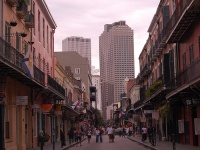Airport
Louis Armstrong New Orleans International Airport
IATA Code: MSYLocation: The airport is situated 14 miles (22km) west of downtown New Orleans.
Time: GMT -6 (GMT -5 from March to November).
Contacts: Switchboard: +1 504 464 0831. Information desk: 504 464 2752.
Transfer to the city: The Airport-Downtown Express (E-2) stop is on the second level of the Airport, near the Delta counter. Tickets to the city cost $1.10. The Airport Shuttle offers a service to/from the hotels throughout the Metropolitan area. The Airport Shuttle booths are open in the baggage claim area for local transportation. They are also providing transportation to/from all of Southeast Louisiana as well as the Mississippi Gulf Coast. Reservations are needed for these types of transport. Please call 1 866 596 2699 or (504) 522 3500 between 9am and 6pm for information and reservations.
Taxis: There are taxicabs available on the lower level outside the baggage claim zone. For one to two persons it costs approximately $28 from the airport to the CBD, for three or more passengers it costs $12 per passenger. Journey time is 30 minutes, dependent on traffic. For queries call the Taxi Bureau on (504) 565-6272.
Car rental: Car rental companies are situated on the lower level of the airport and include Alamo, Avis, Budget, Enterprise, Hertz, National and Thrifty.
Facilities: Banks and business centres offer foreign money exchange, ATMs, travellers cheques and a host of other banking and business services. Internet access is available, as well as tax-free shopping, gift shops, a post office, advance baggage check-in, and a visitor information service. Facilities for the disabled are good. There are restaurants on Concourses A, B, D and in the main ticket lobby, while snacks are available on Concourse C.
Parking: Long and short-term parking options are available.
Departure tax:
Website: www.flymsy.com
Visit worldtravels.com for the full guide to New Orleans. Build a complete New Orleans travel guide and email to your clients - sign up for a trial subscription of World Travels Pro.
New Orleans

When Jean Baptiste Le Moyne picked out the strategic spot on the Mississippi River for his French colony in 1718, little did he know that he had doomed a future city to tragedy nearly 290 years later. Situated on a swamp, and surrounded by the sea, Lake Pontchartrain and the Mississippi River, the subsiding city of New Orleans chose to swim rather than sink with the construction of a system of levees, pumps and canals to protect the city from flooding.
However, on the 30 August 2005, Hurricane Katrina, one of the worst hurricanes ever to hit the United States, slammed into the region, catapulting New Orleans into world headlines that followed the struggle of the community to cope with extensive damage, loss of life and the flooding of more than 75 percent of the city.
Despite the 'I told you so' attitude of much of the world, the proud residents of New Orleans were more determined than ever to rebuild their city, to bring back the jazz, the extravagant celebrations and the 'Big Easy' lifestyle that once made it the party capital of America. Local musicians have returned home, after-dark options are burgeoning and the strains of jazz and blues rhythms are once again echoing through the streets of the atmospheric French Quarter. Legendary Bourbon Street continues to host carnivals and parades, including the annual Mardi Gras, which has a reputation for being the most scandalous and sensational event on the world's festival calendar.
Besides all the partying, New Orleans has plenty of serious sightseeing to offer. The city is full of picturesque historic buildings, lush parks, interesting museums displaying everything from voodoo culture to modern technology, riverboats and historic streetcars, and of course jazz cafes. But for now evidence of the calamity, as well as the city's determination to survive, take first place in any visitor's 'to do' list.







